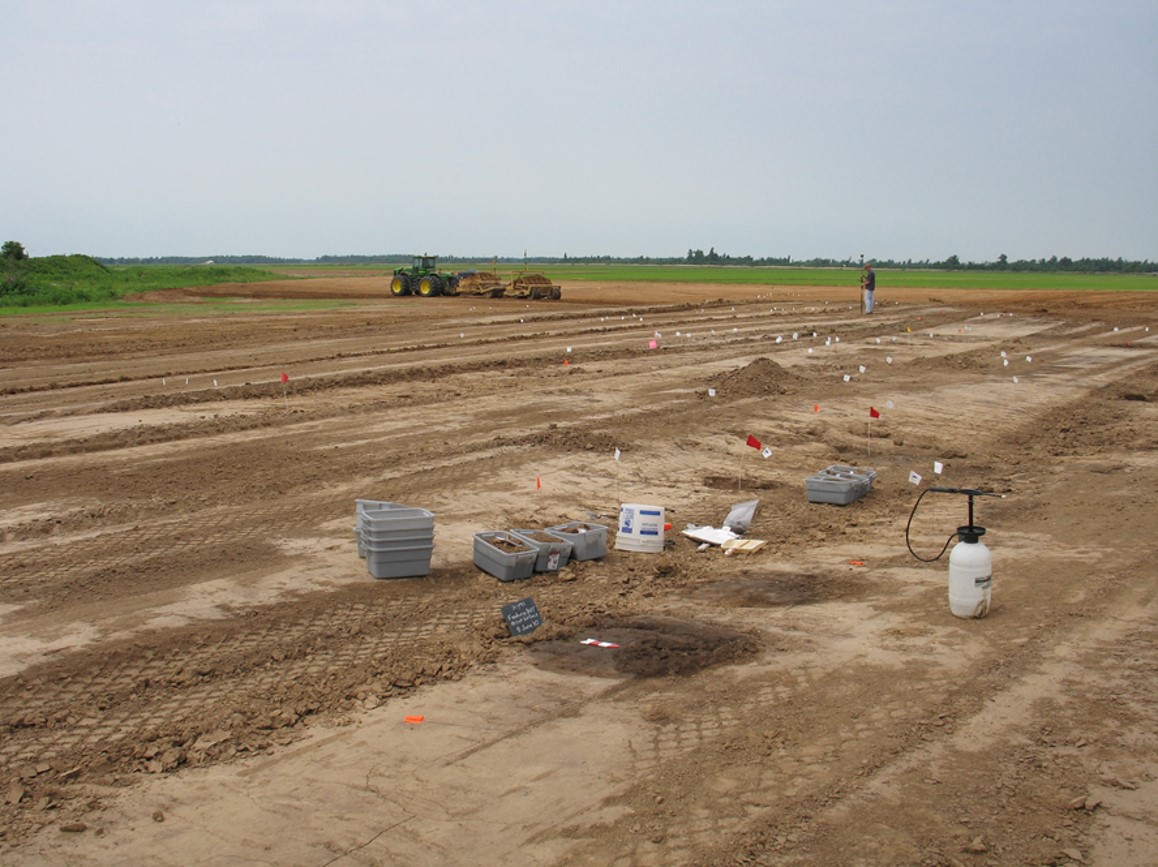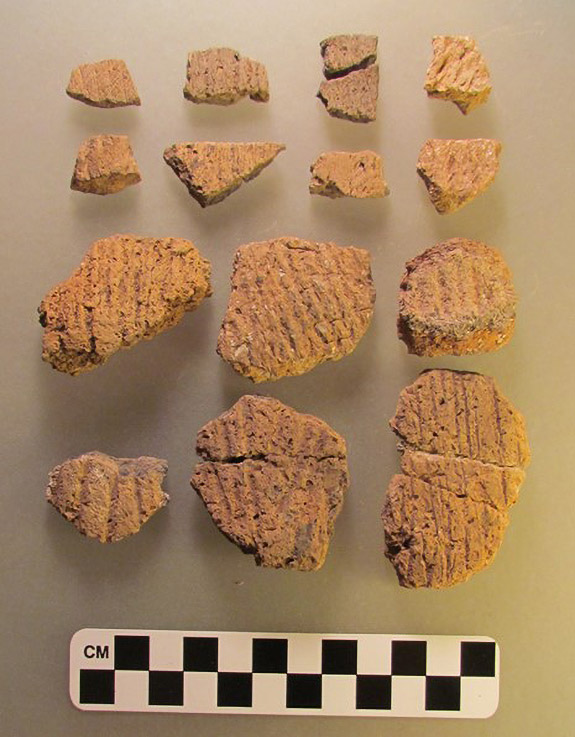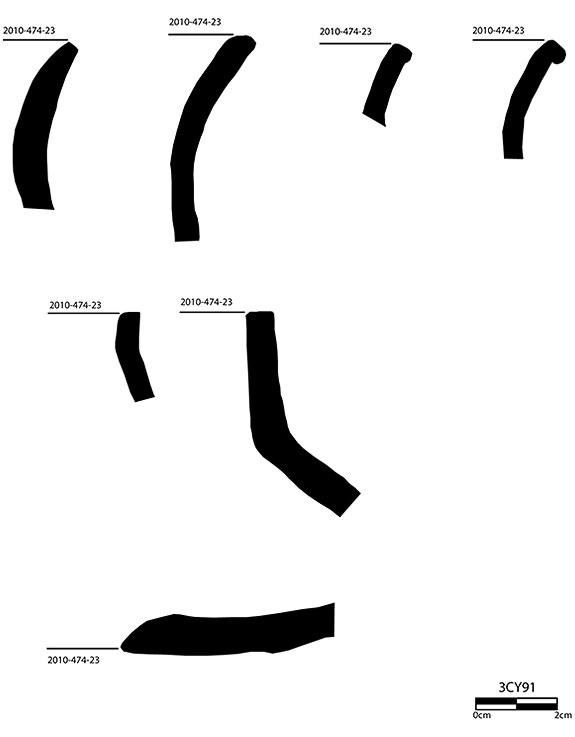
by Juliet E. Morrow, Station Archeologist, ASU-Jonesboro Research Station
Feature of the Month - January 2023
The Bruce Catt site was a Mississippian village on the Cache River. We investigated a small portion of this site in the spring of 2010 as it was being land leveled (Figure 1). Land leveling revealed over 310 features across the southern portion of what may have been a much larger village. Most are posts and refuse-filled pits that contain the remnants of house cleaning. Complete house patterns did not preserve because of damage from historic and modern occupation and modern agricultural practices; however, feature contents provide clues about Transitional (ca. AD 1000–1200) and Middle (ca. AD 1200–1400) period Mississippian diet, habitat, community patterning and regional interaction. Feature 7 was located near the center of the land-leveled area.

Feature 7 was a shallow oval that measured 136 cm northeast to southwest and 80 cm northwest to southeast (Figure 2). The maximum depth was 29 cm as measured from the cut surface (the base of the plow zone). The matrix consisted of very dark grayish brown silty clay loam. The majority of the feature was dry-screened through ¼-inch hardware cloth. A 20-liter sample was water-screened and a 9-liter sample was processed using the flotation technique. Dr. Patti Wright’s examination of botanical remains from four trash-filled pits from the site, including Feature 7, identified mostly wood, hickory and acorn remains, Eastern Agricultural Complex plants (chenopod, erect knotweed, little barley, and maygrass). She also observed the presence of panic grass and cane at the Bruce Catt site. Maize was not present in Feature 7, nor in any of the other features she examined.

I identified and analyzed total of 1157 faunal remains recovered from Feature 7. Combining the dry and water-screened samples, turtle remains are the most abundant, followed by fish, mammal, and bird (Figure 3). The remains of at least five turtles are present, two box turtles and three red-eared sliders. Identified mammal remains include deer, raccoon, skunk, eastern gray squirrel, rabbit, muskrat, mink, and mole. One turkey, one mallard-sized bird, and one blue-winged teal-sized duck are also present. Seventy-four vertebrae from a snake of the family Colubridae may represent subsistence remains; some of the vertebrae are burned. Of the 70 bones identified as white-tail deer from Feature 7, 66 are limb elements or fragments thereof. Only 4 fragments weighing a total of 3.9 grams are non-limb elements: one antler tine fragment, a vertebra fragment, and two isolated teeth. Two long bone shaft fragments show evidence of modification. Each shows what appears to be a drilled hole (Figure 4). Overall, the faunal assemblage reflects processing to optimize nutrition from the bones.

Stone artifacts recovered from Feature 7 include 102 pieces of Pliocene Upland Complex chert debitage from nearby Crowley’s Ridge, 25 fire-cracked rock fragments, 1 sandstone fragment, 14 fragments of hematite (red ochre), 2 pebbles, and 12 pieces of daub and/or fired clay/burned earth.
Ceramic artifacts from Feature 7 include 407 plain shell tempered sherds, 99 shell tempered red-filmed sherds and 3 cord-marked sherds similar to those described as Crosno cord-marked. Figure 5 shows a sample of shell-tempered, cord-marked sherds from the Bruce Catt site. The significance of this ceramic ware is that this was the first known occurrence from a site in this region of Arkansas. Vessel forms from Feature 7 include jars with recurved rims, hooded bottles, funnels and one short-neck jar (Figure 6). The artifacts are consistent with a date of 970 ± 30 and a calibrated age of AD 1020–1160 (Beta- 322697) obtained on wood and nutshell from Feature 7. Based on this radiocarbon date and our current understanding of the time-space grid in northeast Arkansas, Mississippians established a community at the location we call the Bruce Catt site in the early eleventh century (ca. AD 1000) and occupied that location, perhaps continuously, until the late thirteenth century or about AD 1270.


Feature of the Month Series
Archeological features are elements or structures that are nonportable or cannot be easily removed from a site (such as a wall or a post hole). Archeologists document archeological features extensively in the field to record what will otherwise be destroyed in the process of excavation. The records of these features are often all that is left at the end of an excavation. Excellent record keeping is necessary for these features to provide insight into the archeological record and site formation.
In this series, we present interesting and important archeological features that have helped archeologists to better or more fully understand the sites on which they were working. New features will be added monthly. Find the list of features here.
